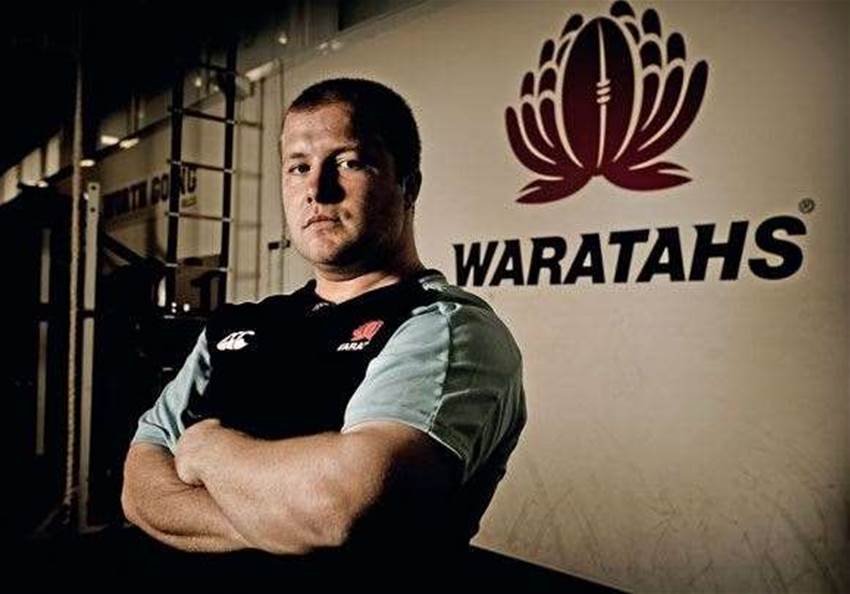The days of Australian scrummaging impotency are over.
 We’d be packing a hundred scrums a week. Images: Warren Clarke
We’d be packing a hundred scrums a week. Images: Warren ClarkeMoving up
“Our upper body weights vary from pre-season to in-season, but throughout the year we do a lot of bench press and a lot of bent-over rows. Most of it comes back to posture, making sure your back’s not arching, ensuring you’re keeping that inverted curve. This transfers directly into your scrummaging shape. So the bent-over row works your grip and lat strength – essential for your bind – but maintaining that good scrummaging posture throughout the exercise also switches on your stomach muscles, working your core strength. Again, the reps tend to be higher in the pre-season and then drop down in-season. You’re bound to lose a little bit of size and strength throughout the season, but ideally your in-season training will maintain what you built in the off-season.“The farmer’s walk is another fun little exercise. You basically load-up two dumbbells with as much weight as you can hold and then walk laps of the gym. This works your grip, your traps and your neck muscles. It’s a really tough exercise because it hits both your aerobic and anaerobic systems – the sweat’s pouring out of you by the end of each lap. We normally walk eight laps of the gym, up and down, with 65kg on each arm. Good fun!”
Bull neck
“A strong neck is crucial for a frontrower. We do a lot of neck work on the Swiss ball. In the most basic drill you place the ball against a wall, then adopt a scrummaging position, resting the crown of your head on the ball. Most of your body weight runs into your neck, working the neck muscles. You can increase the intensity of this exercise by holding weights below you; the more weight, the more pressure going through your neck. “Another exercise is to lie on your back, then form a plank on a Swiss ball, resting the back of your head on the ball. Again, your neck takes the strain and it really works the muscles along the back of your neck. We generally hold these exercises for around a minute.“In a scrum your neck can get in funny positions, so flexibility is a big part of neck conditioning. With all these exercises you have to make sure you work your neck through all the ranges it might reach out on the field – you can’t just work your neck in a neutral position because it’ll go beyond that in a game. So, while we’re doing this Swiss ball work, we’ll often roll our necks around, working movement into the exercise.”
 Ball Work Images:Warren Clarke
Ball Work Images:Warren ClarkeBall work
“For a frontrower, holding the perfect body shape is the key. In the scrum the ideal angle of leg drive (measured at the back of the knee) is between 100 and 120 degrees. So we try and replicate that in the gym by packing in this position against a Swiss ball. Once you’ve established that perfect posture, you can add variety. You can have two players packing on either side of the Swiss ball, giving it that “live” element. Or you can adopt the scrummaging posture with your elbows resting on the ball, extending your arms, putting more pressure on the shoulders and core. Basically, the key with all these exercises is maintaining the perfect pushing posture under fatigue; this is a massive issue when you’re scrummaging.”
Pack ’em
“In a typical scrummaging session we’d begin with a one-on-one drill, where you pack against another prop, focussing on holding a perfect shape. That then builds up to a two-on-one, say a hooker and loose-head packing on a tight-head. Again, the focus is holding the shape under increasing pressure. Then you move to drills, where, for example, one side falls back on engagement, forcing the other side to drive forward and catch up. After these small drills we move to larger scrums, five-on-five, then six-on-six. The focus here is on staying in sync, gelling with the bodies around you. “From there we move to the machine. Personally I gain a lot more from packing against a live opponent, but the machine is great for basics – making sure you’re in sync with the rest of your forward pack, ensuring you have good knee sync before engagement, your back and neck are in a neutral position, you’re engaging at the right height, not shooting toward the ground or driving up. We normally have three cameras on the scrum and after the session we’ll go and analyse all the frontrowers. There’s also a load meter on the scrum that records the impact at collision, the power that’s going through the scrum, etc.“We’d be packing a hundred scrums a week. With the live work we’d probably be doing 20 engagements a week, then there’s the small group stuff and the machine work. But scrummaging is such a high-impact activity, we can’t punch out too many scrums. In a match we average 15 to 16 scrums in 80 minutes and that really takes it out of your body; you need a lot of recovery time after that. In the past we used to do hundreds and hundreds of back-to-back scrums, but thankfully the work we now do on the training paddock is very specific for the numbers we’re likely to rack-up in a game.”
Related Articles
.jpeg&h=172&w=306&c=1&s=1)
Glory dealt big ALW blow as Sydney sign Hana Lowry

Glory sign Stephen Peters as new women's coach













